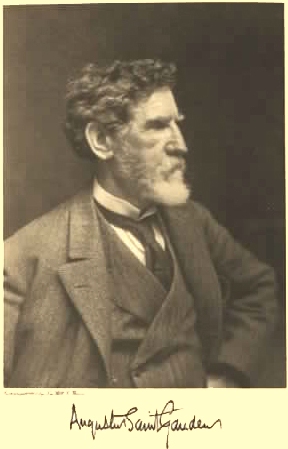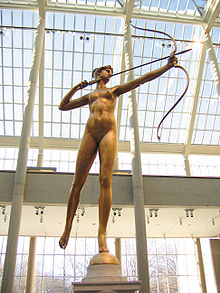Augustus Saint Gaudens
US Coin Designer and Engraver
Augustus Saint Gaudens is known for designing one of the most iconic US coins in history. He was born on March 1, 1848 in Dublin, Ireland to a French father and Irish mother. The family immigrated to the United States when Saint Gaudens was only 6 months old and he would be raised in New York City. At a young age, Augustus displayed an interest and talent in the arts. In fact, he began an apprenticeship as cameo-cutter for a time and enrolled in art classes at Cooper Union and National Academy of Design.
After gaining experience and improving his talent, a 19 year old Saint Gaudens then moved to Paris after completing his apprenticeship in the United States. Once in Paris, he spend a few years at the Ecole des Beaux-Arts, a prestigious art institute in France. Saint Gaudens worked under the supervision of Francois Jouffroy for around three years until 1870. Then he traveled to Rome to begin his first commission work and also continue his study in arts and also architecture in the local city.
Gaudens eventually returned to the America a short time later and won a job to sculpt a bronze artwork for the David Farragut Memorial in 1876, to commemorate Admiral Farragut of the Civil War. He also set up his own studio, became a teacher and advisor to other students, and joined an elite group of artists called the Tilers. While in Rome, Augustus Saint Gaudens met Elizabeth Fisher Homer Nichols. She was the sister of a deaf student named Fisher Homer, whom Augustus met at the art school. Augustus married her on June 1, 1877. Throughout the next few years, Augustus would work with Stanford White to complete the Civil War Memorial, which would be displayed in Madison Square in New York starting on May 25, 1881. The impressive statue provided a major boost in Saint-Gauden's reputation and his name as a skilled sculptor.
Another very popular work of art that Augustus and White collaborated on was the "Diana on the Tower" weathervane, between 1892 and 1894. The Diana was a landmark icon during that time period. It featured a copper statue of a nude woman with a bow and arrow, which was placed on the top of the Madison Square Garden building and would be used to tell the direction of the wind. It was placed on the tallest tower, over 300 feet tall, in Manhattan. It was also the first statue that would be lit up by light at night using electricity, which was a very new invention at the time. That statue was displayed up until 1925 before being taken down in order to demolish the building.
Saint-Gaudens was famous for producing many other works of art commemorating generals of the Civil War. In 1884-1887, one major work was produced and was considered to be one of the finest portrait statues in the nation: the Standing Lincoln statue, which was displayed in Lincoln Park of Chicago. Again, his friend Stanford White helped with many of his works, including the Lincoln Statue. Augustus worked between 1884-1897, 14 years, on the Robert Gould Shaw Memorial located in Boston Common. Many other bronze memorials and busts were crafted by Augustus, including the Adams Memorial, General John A. Logan Monument, Peter Cooper Monument and also the General William Tecumseh Sherman monument located in New York's Central Park.
Later on in his career, Augustus grew an interest in numismatics and coins. He was a an artist of the Beaux-Arts generation who embraced the ideals of the American Renaissance. He referred to his early pieces of relief portraits as Medallions. Not all of them were circular or round shape, but some did resemble coins and he expressed an interest in coins. One portrait that Saint-Gaudens produced was of his friend John Singer Sargent. In this design, he displayed his knowledge of Roman numismatics and the art behind it.
He also made an official medal to commemorate the centennial of the inauguration of our first president, George Washington. This work was completed in 1889 and Richard Watson Gilder described it as the first medal in our nation that held real artistic value and that he strongly hoped it would influence the design of US coinage. It just so happens that President Theodore Roosevelt had a strong passion to revolutionize and redesign all of the US coins. Roosevelt felt that Saint-Gaudens was the perfect man for the job and so he commissioned him first to redesign the ten and twenty dollar gold coins along with the one cent piece.
So Augustus designed two gold coin pieces for two different denominations. They are famously known as the $10 Gold Indian Head Eagle and the $20 Gold Saint-Gaudens Double Eagle. He produced these designs for the US Mint between 1905 and 1907 while the Mint was under the reins of Chief Engraver Charles E. Barber. These coins, especially the gold twenty dollar Saint Gaudens Double Eagle, are considered some of the most beautiful coins ever produced in the United States and even of the entire world. Augustus also created a pattern design for the one cent piece, but it was never produced. He would be known as the first sculptor in America to design official US coins. One of his assistants whom he once mentored at his private studio was Bela Lyon Pratt. Pratt would also design other revolutionary gold coins alongside Augustus.
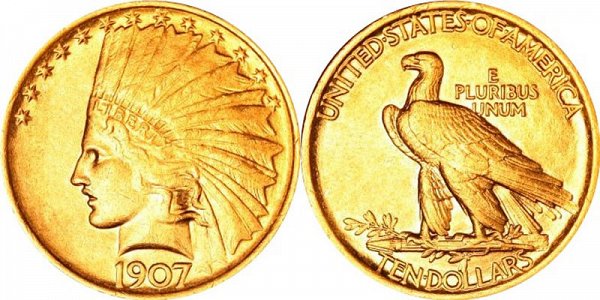
Design of the $10 Gold Indian Head Eagle coin by Augustus Saint-Gaudens.
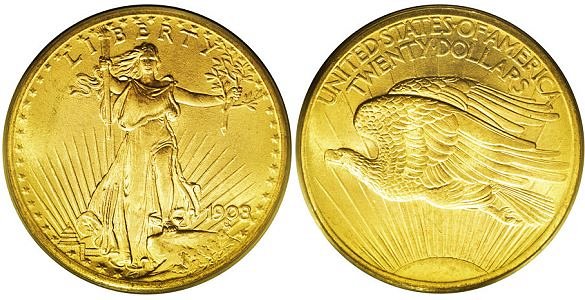
Design of the $20 Gold Saint Gaudens Double Eagle coin by Augustus Saint-Gaudens.
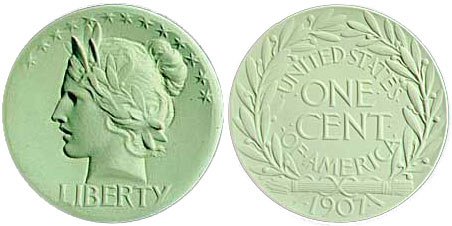
Proposed design of the US one cent piece by Augustus Saint-Gaudens - Coin was never produced.
Both gold coins were struck in 1907. The gold double eagle coin was originally struck with an ultra high relief. This meant it was highly concave with a large bowl-like surface into the coin. Sometimes the Mint had to strike the coin 11 times just to get the high details onto the coin. Not many of these were produce, only about 20 of them. A problem with these coins were noticed immediately in that they didn't stack properly and were unfit for the public. These ultra high-relief Saint-Gaudens Double Eagles are worth millions to collectors today. One sold in 2005 for nearly $3,000,000.
The mint eventually decided to alter the coin from an ultra high-relief to just a high relief strike. These only took about 3 strikes to produce, but they were still unfit for commerce. Only 12,317 of these kinds of coins were produced and are in very high demand to numismatists and collectors today. One famous variety is the "Saint Gaudens High relief Roman Numerals 1907", which featured the date as Roman Numerals MCMVII instead of the Arabic 1907 numbers. During the same year of 1907, the coin was modified once more into a normal-relief strike, which produced a flatter coin that could be stacked and was acceptable to the public. This was the final style that was used for all future double eagles minted between 1907 and 1933.
Saint-Gauden's double eagle was discontinued in 1933. Although the design was resurrected again in 1986 in a coin called the American Gold Eagle used in US bullion coins. The obverse featured Saint-Gauden's liberty, but the reverse of the coin was of a different design. These coins were produced as bullion coins with 99.99% pure gold in $5 tenth ounce, $10 quarter ounce, $25 half ounce and $50 full ounce gold denominations. Also in 2009, the US Mint produced a one-year commemorative Ultra High Relief $20 Saint Gaudens Double Eagle with the original obverse and reverse design.
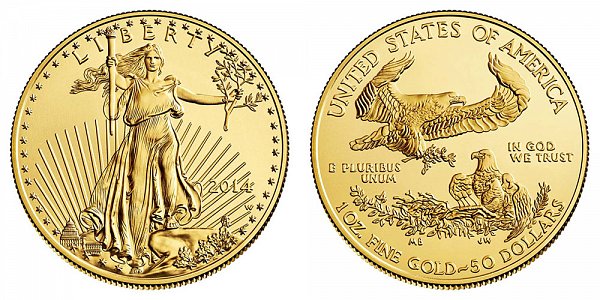
Design of the Saint Gaudens obverse for the US American Gold Eagle Bullion Coins.
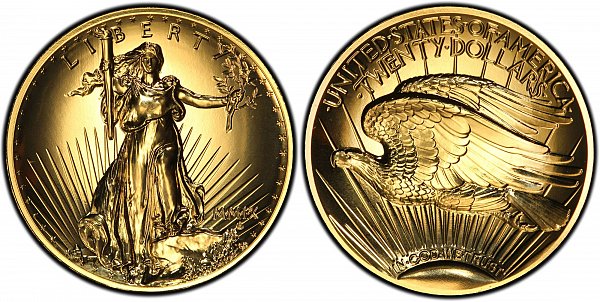
Special Issue of the MMIX 2009 Ultra-High Relief Saint Gaudens Gold Double Eagle.
Many wonder why Augustus Saint-Gaudens didn't design many more coins after he produced some of the very finest designs in US history. It turns out that Augustus had a very untimely death. Back in 1900, he was diagnosed with cancer and decided to move to his Federal house where his gardens and barn-studio were based. Typically, this was a summer home for him and his family since around 1885. It was located in Cornish, New Hampshire. Due to his loss of energy, he was partially in retirement, but he still did work. In 1904, Augustus was chosen to become one of the first seven members of the American Academy of Arts and Letters. Unfortunately during that same year, his barn studio burned down and he lost much of his work.
Saint-Gaudens was known as being the founder of the Cornish Colony, which was a group of artists, painters, designers, architects, writers and sculptors that him and his brother, Louis Saint-Gaudens, attracted to his personal studio and gardens. Many well known artists were involved, including Maxfield Parrish, Kenyon Cox, Charles Platt, Paul Manship and many others. Unfortunately, Augustus Saint Gaudens passed away on August 3, 1907 and the group slowly disbanded. His elaborate garden and house are now preserved in his very own national park: The Saint-Gaudens National Historic Site.
